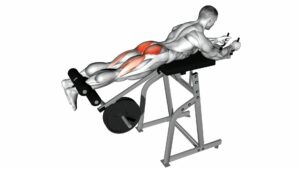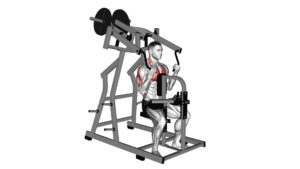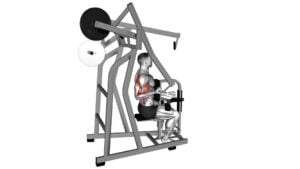Lever Reverse Hyperextension (Plate Loaded) (Female) – Video Exercise Guide & Tips

Looking to strengthen your lower back and glutes? Check out this video exercise guide for lever reverse hyperextension, specifically designed for females.
Watch This Exercise Video
In just a few minutes, you'll learn the proper form and technique, as well as modifications and progressions to challenge yourself. Avoid common mistakes and get expert tips on incorporating this exercise into your workout routine.
Get ready to feel the burn and see results with lever reverse hyperextension. Let's get started!
Key Takeaways
- Lever reverse hyperextension strengthens glutes, hamstrings, and lower back muscles.
- It improves hip extension and enhances core stability.
- Lever reverse hyperextension can help prevent and rehabilitate lower back injuries.
- Incorporating lever reverse hyperextension into a workout routine can improve athletic performance and power.
Benefits of Lever Reverse Hyperextension for Females
Discover the numerous benefits that Lever Reverse Hyperextension can offer you as a female athlete.
One of the key advantages of this exercise is its ability to increase glute strength. By engaging your glute muscles during the lever reverse hyperextension, you can effectively target and strengthen these important muscles. This is particularly beneficial for female athletes as strong glutes can improve athletic performance in various sports, such as running, jumping, and change of direction movements.
In addition to glute strength, lever reverse hyperextension is a great exercise for female athletes because it helps to improve hip extension. Hip extension is an essential movement for many sports, including sprinting and kicking. By performing lever reverse hyperextensions, you can strengthen the muscles responsible for hip extension, such as the glutes and hamstrings, leading to enhanced power and explosiveness in your athletic movements.
Furthermore, lever reverse hyperextensions can also help to improve core stability. The movement requires you to engage your core muscles to maintain proper form and stability throughout the exercise. This can lead to improved balance, posture, and overall core strength, which are all crucial for female athletes in various sports.
Proper Form and Technique for Lever Reverse Hyperextension
To perform the Lever Reverse Hyperextension exercise with proper form and technique, you should use a specific plate-loaded machine. Here is a step-by-step guide to help you perform this exercise correctly:
- Adjust the machine: Set the footplate at a comfortable height and secure your feet under the pads. Adjust the lever arm to align with your hip joint.
- Starting position: Lie face down on the machine with your hips resting on the pad and your upper body hanging off the edge. Your knees should be slightly bent and your hands can grip the handlebars for stability.
- Execution: Keeping your core engaged and your back straight, slowly lower your upper body towards the floor. Allow your hips to hinge naturally as you lower yourself down. Pause briefly at the bottom position.
- Return to starting position: Squeeze your glutes and hamstrings to raise your upper body back up until it's level with your hips. Keep your back straight throughout the movement.
Benefits of lever reverse hyperextension for strength training:
- Targets the glutes, hamstrings, and lower back muscles.
- Improves hip extension and overall posterior chain strength.
- Enhances athletic performance and power.
- Helps prevent and rehabilitate lower back injuries.
By following these proper form and technique guidelines, you can maximize the effectiveness of the lever reverse hyperextension exercise.
Now, let's move on to the next section about modifications and progressions for this exercise.
Modifications and Progressions for Lever Reverse Hyperextension
Now let's explore some ways you can modify and progress the Lever Reverse Hyperextension exercise for optimal results.
There are several modifications you can make to adjust the difficulty level of this exercise. If you're a beginner, you can start by using lighter weights or even just your body weight. This will allow you to focus on mastering the correct form and technique before adding more resistance. As you become more comfortable, you can gradually increase the weight or resistance to challenge your muscles further.
Another modification you can try is adjusting the range of motion. If you find the full range of motion too challenging, you can reduce the range by stopping before your torso is parallel to the ground. This will still target your glutes and hamstrings while allowing you to build strength gradually.
To progress the Lever Reverse Hyperextension exercise, you can increase the weight or resistance over time. This will help you continuously challenge your muscles and promote further strength gains. Additionally, you can also experiment with different tempos, such as slowing down the lowering phase or adding a pause at the top of the movement, to increase the intensity of the exercise.
By implementing these modifications and progressions, you can effectively customize the Lever Reverse Hyperextension exercise to your specific fitness level and goals.
Now that you know how to modify and progress this exercise, let's move on to discussing common mistakes to avoid during lever reverse hyperextension.
Common Mistakes to Avoid During Lever Reverse Hyperextension
To avoid common mistakes during the Lever Reverse Hyperextension exercise, make sure you maintain proper form and technique throughout the movement. By doing so, you can prevent injuries and maximize your results. Here are four common mistakes to avoid:
- Rounding your back: Keep your back straight throughout the entire movement. Avoid rounding your back, as this can put excessive strain on your spine and increase the risk of injury.
- Using momentum: Avoid using momentum to swing your body up and down. Instead, focus on using your glutes and hamstrings to lift your legs. This will ensure that you're targeting the intended muscles and getting the most out of the exercise.
- Lifting your legs too high: While it's important to lift your legs, avoid lifting them too high. Aim to bring your legs parallel to the ground, as lifting them higher can strain your lower back and compromise your form.
- Neglecting proper breathing: Remember to breathe properly throughout the exercise. Inhale as you lower your legs and exhale as you lift them. This will help stabilize your core and maintain control during the movement.
Tips for Incorporating Lever Reverse Hyperextension Into Your Workout Routine
Start by incorporating lever reverse hyperextension into your workout routine with three to four sets of 10-12 repetitions. Lever reverse hyperextension is one of the best exercises for glutes, as it targets the gluteus maximus and hamstrings effectively.
To get the most out of this exercise, it's important to focus on proper form and technique. First, adjust the machine to fit your body positioning. Position yourself face down on the machine with your hips resting on the pad and your feet secured under the foot pad. Keep your legs straight and your torso aligned with the machine.
As you begin the exercise, engage your glutes and hamstrings to lift your legs upward against the resistance. Make sure to maintain control throughout the movement and avoid using momentum.
To increase the intensity of the exercise, you can add weights to the machine or use ankle weights. Start with lighter weights and gradually increase as you get stronger.
Incorporating lever reverse hyperextension into your workout routine can help strengthen and tone your glutes and hamstrings. Remember to listen to your body, start with a weight that challenges you but still allows you to maintain proper form, and gradually increase the intensity over time.
Frequently Asked Questions
What Is the Recommended Weight to Use for the Lever Reverse Hyperextension Exercise?
The recommended weight for the lever reverse hyperextension exercise depends on your fitness level and goals. It's important to start with a weight that challenges you but allows you to maintain proper form and technique.
As you progress, you can gradually increase the weight to continue challenging your muscles. Remember to listen to your body and adjust the weight accordingly to prevent injury and promote optimal results.
Can Lever Reverse Hyperextension Help in Improving Lower Back Pain?
Lever reverse hyperextension can be beneficial for improving lower back pain and overall core strength. It can also help with posture and spinal alignment.
By engaging your lower back muscles, this exercise can strengthen and stabilize your spine, reducing discomfort and promoting better alignment.
Incorporating lever reverse hyperextension into your workout routine can provide a targeted and effective way to alleviate lower back pain and improve your overall core strength and posture.
How Often Should Lever Reverse Hyperextension Be Performed for Optimal Results?
To achieve optimal results, how often should you perform lever reverse hyperextension?
It's important to consider the frequency of this exercise. Additionally, finding the optimal weight is crucial for effectiveness.
By incorporating lever reverse hyperextension into your routine consistently and using the appropriate weight, you can maximize your results and improve your lower back strength.
Remember to consult a professional or trainer for guidance on the recommended frequency and weight for this exercise.
Can Lever Reverse Hyperextension Help in Strengthening the Glutes?
Lever reverse hyperextension is a great exercise for strengthening your glutes. During this exercise, your glutes are activated, helping to build strength and definition in that area. In addition to targeting the glutes, lever reverse hyperextension also provides benefits for overall lower body strength.
Is Lever Reverse Hyperextension Suitable for Individuals With a History of Lower Back Injuries?
If you have a history of lower back injuries, it's important to consider alternative exercises that won't exacerbate your condition. Lever reverse hyperextension may not be suitable for individuals with this history, as it can put strain on the lower back.
It's crucial to take precautions when performing this exercise, such as starting with lighter weights and focusing on proper form. Consulting with a healthcare professional or a certified trainer is recommended to ensure your safety.
Conclusion
Incorporating lever reverse hyperextension into your workout routine can provide numerous benefits for females. This exercise helps strengthen the lower back, glutes, and hamstrings while improving core stability.
By maintaining proper form and technique, and avoiding common mistakes, you can maximize the effectiveness of this exercise. Additionally, modifications and progressions can be implemented to challenge yourself and continue making progress.
Consider adding lever reverse hyperextensions to your routine to enhance your strength and overall fitness.

Author
Years ago, the spark of my life’s passion ignited in my mind the moment I stepped into the local gym for the first time. The inaugural bead of perspiration, the initial endeavor, the very first surge of endorphins, and a sense of pride that washed over me post-workout marked the beginning of my deep-seated interest in strength sports, fitness, and sports nutrition. This very curiosity blossomed rapidly into a profound fascination, propelling me to earn a Master’s degree in Physical Education from the Academy of Physical Education in Krakow, followed by a Sports Manager diploma from the Jagiellonian University. My journey of growth led me to gain more specialized qualifications, such as being a certified personal trainer with a focus on sports dietetics, a lifeguard, and an instructor for wellness and corrective gymnastics. Theoretical knowledge paired seamlessly with practical experience, reinforcing my belief that the transformation of individuals under my guidance was also a reflection of my personal growth. This belief holds true even today. Each day, I strive to push the boundaries and explore new realms. These realms gently elevate me to greater heights. The unique combination of passion for my field and the continuous quest for growth fuels my drive to break new ground.







